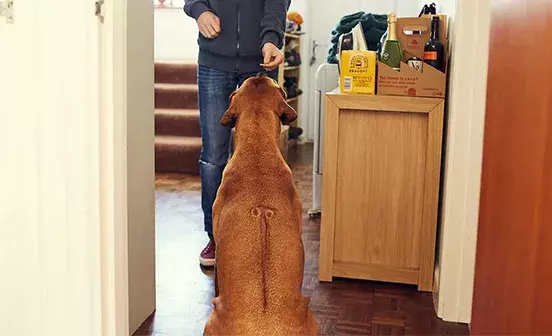
Despite what people might first think, training and caring for a deaf dog, or a dog with reduced hearing is very similar to any other dog care training. A deaf dog won’t always hear you approaching, for example, so it’s important to take care not to startle them. You may also need to get creative when trying to put yourself in their eyeline to get their attention. Aside from that, though training a deaf dog is all about positive reinforcement: rewarding behaviours we want to be repeated and ignoring behaviours we do not want, exactly the same as with a sighted dog.
Training a deaf dog will take time and patience, but that’s the same for most, if not all dogs! As owners all we need to do it adjust our training methods slightly and think differently about how we care for them to suit their needs.
Take a look at our video for some deaf dog training basics and useful hand signals, or follow along with the steps below:
HOW NOT TO STARTLE YOUR DEAF DOG
Deaf dogs won’t hear you coming, so can often be startled by an unexpected touch. It’s not always possible to make your deaf dog aware of your presence before you touch them, so it’s a good idea to practise desensitisation exercises to make them more comfortable with responding to an unexpected touch.
To do this, when your dog is relaxed, but not facing you, very gently touch them somewhere not too sensitive (their shoulder is a good spot) When they turn around, immediately greet them with a treat. Repeat this a few times, and over time your dog will begin to associate an unexpected touch with good things happening and will be less likely to respond in a frightened way.
GETTING A DEAF DOG'S ATTENTION
There may be times you need to get the attention of your deaf dog when they are at a distance and facing away from you, for example if they have found their way into the bins or if you need to call them back in from the garden. If you need their attention inside the house the easiest thing is to walk into their eye line to get their attention. If that’s not possible then you could try lightly stomping your feet. This isn’t to frighten them, but just so they feel the vibrations of the floor. Alternatively, you can try turning a light on and off. If you’re outside we would generally recommend that deaf dogs are kept on a long-lead unless the area is completely secure, so you can gently move the lead to get their attention, or alternatively try throwing a ball across their field of vision.
HELP A DEAF DOG KEEP TRACK OF YOU
A deaf dog won’t hear you as you move about the house, leave the room, or even leave the house itself. Turning around to find that you are suddenly missing can cause anxiety and may lead to them searching around trying to find you. This can become even more stressful if you have left the house completely and are nowhere to be found. Before leaving a room, it’s a good idea to calmly get your dog’s attention so that they can see what you are doing. This is particularly important when leaving the house, so they do not try to search for you unsuccessfully. As with any dog, you can help a blind dog to feel more comfortable with spending time by themselves by very gradually building up the length of time you leave them on their own for and providing them with ways to occupy themselves when you do, such as a KONG, so that their time by themselves is a positive experience.
TRAINING YOUR DEAF DOG WITH HAND SIGNALS
As verbal humans we tend to focus on voice cues, but we also use hand signals and different hand, arm and body gestures alongside these. It’s those gestures which your deaf dog will learn to respond to. When teaching hand signals to a deaf dog, it is important that that they are obvious, clear and consistent. You may need to exaggerate your movements initially and then reduce them to smaller signals over time. As with any training it is important to remember that the training should be fun and rewarding for both of you! It may seem unnecessary to speak when training a deaf dog, but it can actually help the process. Smiling and speaking as you sign, particularly when praising, can help the dog, as they will pick up on your facial expressions and positive body language.
TEACHING A “GOOD DOG” SIGNAL TO A DEAF DOG
Use this to tell the dog that they have done something positive or that you are happy with.
- When your dog does something positive, make an ‘O’ with your thumb and index finger and make sure they are looking at you, or can see you.
- You can use this sign whenever your dog performs a desired behaviour and then reward with a treat. This sign can be used as a form of 'clicker training' for a deaf dog and is useful as a basic signal both day to day and when training.
TEACHING A “WATCH ME” SIGNAL TO A DEAF DOG
This command is useful to gain and hold your dog’s attention, particularly if they are getting distracted or worried by something in the environment.
- Show your dog a treat, then hold it out to the side, nearly at arm’s length. Hold the treat between your thumb and middle finger, with your index finger pointing back at your face.
- Your dog will naturally look over to the treat, but the moment they stop looking at it and make eye contact with you, give them the ‘good dog’ signal and reward them with the treat.
- Keep practising until the dog is consistently making eye contact when you produce the treat in this way.
- Over time you can begin to increase the length of time they maintain eye contact before you give them the treat. If they break eye contact, you are moving too quickly.
- Once this is mastered you can begin using the hand signal without the treat in your hand, but still reward them when they get it right.
TEACHING A "SIT" SIGNAL TO A DEAF DOG
As with dogs who can hear, this behaviour is a useful one to ask for as it’s calm and still and should help take the energy out of a situation.
- Show your dog a treat in your hand and let them put their nose to it.
- Whilst they’re sniffing the treat, raise your hand up a little and over their head, toward their back. This movement encourages them to look up and put their rear end on the floor.
- As soon as they reach the sitting position, reward them with the treat.
- Repeat this until they are doing it consistently. Over time you can start to reduce the amount of direction you give them with your hand signal until eventually you can just make a fist, bend your arm at the elbow and bring your hand up to your shoulder.
- When your dog sits give them the ‘good dog’ signal and a treat.
- Gradually you can phase out the treats, so your dog responds just to the hand gesture.
TEACHING A "DOWN" SIGNAL TO A DEAF DOG
This is another good behaviour to ask for to encourage calm behaviour.
- To teach a ‘down’ start by giving your dog the ‘sit’ command.
- Then, holding a treat in the palm of your hand between your thumb and index finger, show them the treat.
- Turn your hand over, palm downwards, but with the treat still visible between your thumb and finger and lure your dog’s nose down between their front paws. When they lie down to get the treat, give it to them, and give the ‘good dog’ signal so they can see it.
- Repeat this motion and gradually increase the distance between your hand and the ground, until the dog responds to you moving your hand down while you’re stood up.
TEACH A "STAY" SIGNAL TO A DEAF DOG
This is useful when you need your dog in one position, for example while you clean up something you or they might have knocked over if you’re unable to move them out of the room.
- First ask your dog to sit and then reward them.
- Give the ‘stay’ command by holding your arm out straight with your palm forward towards them.
- Take a small step backwards, and if they don’t get up or follow you, step back towards them, give the ‘good dog’ signal and reward them.
- If they stand or move, calmly get them back into a sit and repeat the exercise.
- Repeat this over time, slowly increasing the number of steps you take backwards. Only increase the distance when your dog is completely comfortable with each number of steps before.

TEACH A RECALL SIGNAL TO A DEAF DOG
Recall is a very useful command, even if you do not intend to have your dog off lead in public.
- A deaf dog needs to be able to see you to respond to this command, so first get their attention by getting into their field of vision and waving to them.
- Once they have seen you, hold your arms out wide, be enthusiastic and make yourself look as happy as possible so your dog is encouraged to come back to you.
- When they do, give them the ‘good dog’ signal, reward with a treat and give them some affection.
TEACH A "WALK ON" SIGNAL TO A DEAF DOG
Although you want your dog to be able to focus on you and respond to your commands, you also want them to enjoy the sights and smells on a walk. ‘Walk on’ is a useful command to direct them to look ahead and carry on.
- Holding a treat in your hand, bend your arm at the elbow and point your index finger in the direction you want them to walk, releasing the treat as you do so.
- As your dog goes to retrieve the treat, use the momentum and keep walking in that direction. Over time your dog will learn to face and walk in the direction you point.
If you’re struggling or feel like you could use some extra support, we would recommend getting in touch with a qualified trainer who can help with your situation and find what works best for you and your dog.



